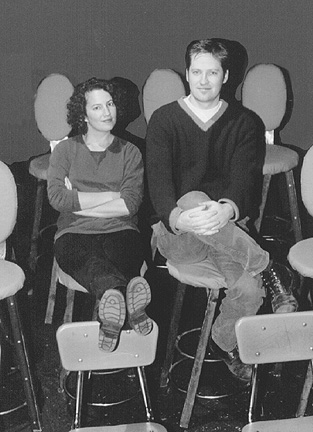
David Russell & Tina LaPadula.
The atmosphere may be offputting at first. On any given night, the bank of computers on the lefthand wall of the cafe is filled with people intently surfing the net. It is Seatlle's premiere cyber cafe, and it may be the only place in town where cyberspace and the more traditional aspects of a community center successfully coexist. If you continue to look around the room, you'll see people reading the paper, eating Italian sandwiches and drinking espresso; people smoking, drinking wine, reading, talking. In the area called the Living Room, someone might be sitting at the grand piano, or standing absorbed with the art that hangs from the walls. And, if you're really paying attention, your listening gaze will wander toward the true heart of the Speakeasy phenomenon: the Back Room.
 |
David Russell & Tina LaPadula. |
Thus the Back Room space - complete with proscenium, movie screen, cloth-covered high-backed stools (risers were too bulky), and full sound and light systems - has become host to a number of first-time events as well as ongoing, regularly scheduled events.
An example of the former is last October's festival of East German "Indianerfilme," westerns filmed in the unlikely locales of Yugoslavia, Romania, East Germany, the Soviet Union, and Cuba - films never seen before on this side of the Berlin Wall. The screening of two of these films, Die Sohne der Grossen Barin (The Sons of Great Bear) and Apachen (Apaches), sparked a lively dialogue after the show on the portrayals of Native Americans in popular culture. Jens Wazel, producer of the Wild East Goes West project, praises Russell and the rest of the Speakeasy staff for being so "accomodating," and credits them in part for the series' success across the US. He plans to return to the Speakeasy this year with another East German film fest. Stay tuned for his website, which will be at http://www.speakeasy.org/wildeast/.
The physical dimensions of the space have also compelled artists to try their hand at short works designed within constaints similar to those used in On The Board's 12 Minutes Max series. Three Knocks and a Whistle, for example, a quarterly weekend series curated by Russell, LaPadula, and choreographer Crispin Spaeth, brings ten-minute monologues, musical works coupled with dance, and film and video shorts to the scene. the success of Three Knocks in particular attests to the fluid exchange of ideas and resources possible when artists start talking. Russell says that the artists often sit around afterward and give each other constructive feedback, in effect creating an artists' cross-cultural workshop.
Still other groups use the Back Room for civic events (for example, an open discussion forum with Jim McDermott), children's classes (Puget Sound Community School's monthly sleepover), and offbeat retreats, such as April's four-day CIA Film Festival and Fundraiser, featuring "the greatest compilation of documentary and video tape on the CIA and covert operations ever shown in one place."
Every month there are changes to the Back Room calendar (for example, May and June introduces Cold Water Waltz, a multimedia presentation of film, live music, and silent-movie-style acting on the sinking of the Titanic). But the following organizations call the Back Room home; you can find them there come rain or shine:
In the world of the Internet, a community has formed which presumable does not recognize gender, race, handicap, or creed - only mind. Often I envision that world as one huge, dark continent, rippling with mystery, danger, tropical fever; runners carry torches from village to village, lighting the darkness. Those runners are the purveyors of the Web, but they are also the local heroes, diehard artists and activists who do not see the death of communication and community through cyberspce. Instead, they insist on creating a venue (village) that allows communication in one of its most powerful forms: performance.
David Russell and Tina LaPadula are two such torch-bearers. Russell points out that the Speakeasy's symbol on the Internet is a radio tower - a beacon in the dark night, something that radio and TV were "supposed to be."
"Cross-cultural" Performance Venues
curators (206) 726-3927. Checkout the Speak Easy on-line calendar.
readings. May 13 is Colleen McElroy and Charles d'Ambrosio; June 9 is Chris Mazza
and Stacey Levine. Contact Matthew Stadler (206) 323-6800.
currently hosts readings every Sunday evening at the Globe Cafe on Capitol Hill,
14th Ave. E. near Madison. In May they play host to Small Press Fest, readings and
discussions from the likes of Subtext, Point No Point, and Real Change. Contact
Elliott Bronstein (206) 547-4585.
room, but hosts a "Fuckall" open mike the first Wednesday of every month. "Not
always refined, but definitely entertaining." Contact Todd Harmon (206) 441-9484.
[Home]
[This Issue's Directory]
[WFP Index]
[WFP Back Issues]
[E-Mail WFP]





Contents this page were published in the May/June, 1997 edition of the Washington Free Press.
WFP, 1463 E. Republican #178, Seattle, WA -USA, 98112. -- WAfreepress@gmail.com
Copyright © 1997 WFP Collective, Inc.